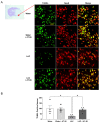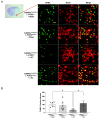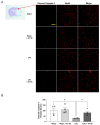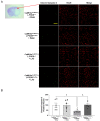Protective Effect of Low-Dose Alcohol Consumption against Post-Ischemic Neuronal Apoptosis: Role of L-PGDS
- PMID: 35008575
- PMCID: PMC8745720
- DOI: 10.3390/ijms23010133
Protective Effect of Low-Dose Alcohol Consumption against Post-Ischemic Neuronal Apoptosis: Role of L-PGDS
Abstract
Ischemic stroke is one of the leading causes of permanent disability and death in adults worldwide. Apoptosis is a major element contributing to post-ischemic neuronal death. We previously found that low-dose alcohol consumption (LAC) protects against neuronal apoptosis in the peri-infarct cortex following transient focal cerebral ischemia. Lipocalin-type prostaglandin D2 synthase (L-PGDS), which is mainly localized in the central nervous system (CNS), was previously shown to inhibit neuronal apoptosis. Therefore, we determined whether L-PGDS is involved in the protective effect of LAC against post-ischemic neuronal apoptosis. Wild-type (WT), CaMKIIαCreERT2/+/L-PGDS+/+, and CaMKIIαCreERT2/+/L-PGDSflox/flox mice on a C57BL/6J background were gavage fed with ethanol or volume-matched water once a day for 8 weeks. Tamoxifen (2 mg/day) was given intraperitoneally to CaMKIIαCreERT2/+/L-PGDS+/+ and CaMKIIαCreERT2/+/L-PGDSflox/flox mice for 5 days during the fourth week. AT-56 (30 mg/kg/day), a selective inhibitor of L-PGDS, was given orally to AT-56-treated WT mice from the fifth week for four weeks. Cerebral ischemia/reperfusion (I/R) injury, TUNEL-positive neurons, and cleaved caspase-3-positive neurons were measured at 24 h of reperfusion after a 90 min unilateral middle cerebral artery occlusion (MCAO). We found that 0.7 g/kg/day but not 2.8 g/kg/day ethanol significantly upregulated L-PGDS in the cerebral cortex. In addition, 0.7 g/kg/day ethanol diminished cerebral ischemia/reperfusion (I/R) injury and TUNEL-positive and cleaved caspase-3-positive neurons in the peri-infarct cortex in WT and CaMKIIαCreERT2/+/L-PGDS+/+ mice. Furthermore, the neuroprotective effect of 0.7 g/kg/day ethanol was alleviated in AT-56-treated WT and CaMKIIαCreERT2/+/L-PGDSflox/flox mice. Our findings suggest that LAC may protect against cerebral I/R injury by suppressing post-ischemic neuronal apoptosis via an upregulated L-PGDS.
Keywords: L-PGDS; apoptosis; brain; ethanol; ischemic stroke.
Conflict of interest statement
The authors declare no conflict of interest.
Figures








Similar articles
-
The Role of Endothelial L-PGDS in the Pro-Angiogenic and Anti-Inflammatory Effects of Low-Dose Alcohol Consumption.Cells. 2024 Dec 5;13(23):2007. doi: 10.3390/cells13232007. Cells. 2024. PMID: 39682755 Free PMC article.
-
L-PGDS Mediates Vagus Nerve Stimulation-Induced Neuroprotection in a Rat Model of Ischemic Stroke by Suppressing the Apoptotic Response.Neurochem Res. 2017 Feb;42(2):644-655. doi: 10.1007/s11064-016-2121-8. Epub 2016 Nov 29. Neurochem Res. 2017. PMID: 27900597
-
Chronic Low-Dose Alcohol Consumption Attenuates Post-Ischemic Inflammation via PPARγ in Mice.Int J Mol Sci. 2021 May 12;22(10):5121. doi: 10.3390/ijms22105121. Int J Mol Sci. 2021. PMID: 34066125 Free PMC article.
-
The biological efficacy of Apelin against focal transient cerebral ischemia-reperfusion injury. A systematic review and meta-analysis of animal studies.Brain Res. 2024 Jun 15;1833:148887. doi: 10.1016/j.brainres.2024.148887. Epub 2024 Mar 27. Brain Res. 2024. PMID: 38552935
-
Caspase inhibitors: prospective therapies for stroke.Neuroscientist. 2013 Apr;19(2):129-36. doi: 10.1177/1073858412447875. Epub 2012 May 29. Neuroscientist. 2013. PMID: 22645109 Free PMC article. Review.
Cited by
-
Targeting PTGDS Promotes ferroptosis in peripheral T cell lymphoma through regulating HMOX1-mediated iron metabolism.Br J Cancer. 2025 Mar;132(4):384-400. doi: 10.1038/s41416-024-02919-w. Epub 2024 Dec 20. Br J Cancer. 2025. PMID: 39706989 Free PMC article.
-
The Role of Endothelial L-PGDS in the Pro-Angiogenic and Anti-Inflammatory Effects of Low-Dose Alcohol Consumption.Cells. 2024 Dec 5;13(23):2007. doi: 10.3390/cells13232007. Cells. 2024. PMID: 39682755 Free PMC article.
-
Light Alcohol Consumption Promotes Early Neurogenesis Following Ischemic Stroke in Adult C57BL/6J Mice.Biomedicines. 2023 Apr 2;11(4):1074. doi: 10.3390/biomedicines11041074. Biomedicines. 2023. PMID: 37189692 Free PMC article.
-
Early predictive value of lipocalin-type prostaglandin D synthase for 28-day mortality in cardiac arrest patients: study protocol for a prospective study.BMJ Open. 2024 Jun 5;14(6):e083136. doi: 10.1136/bmjopen-2023-083136. BMJ Open. 2024. PMID: 38839386 Free PMC article.
References
-
- Benjamin E.J., Blaha M.J., Chiuve S.E., Cushman M., Das S.R., Deo R., de Ferranti S.D., Floyd J., Fornage M., Gillespie C., et al. Heart Disease and Stroke Statistics-2017 Update: A Report From the American Heart Association. Circulation. 2017;135:e146–e603. doi: 10.1161/CIR.0000000000000485. - DOI - PMC - PubMed
MeSH terms
Substances
Grants and funding
LinkOut - more resources
Full Text Sources
Medical
Molecular Biology Databases
Research Materials

